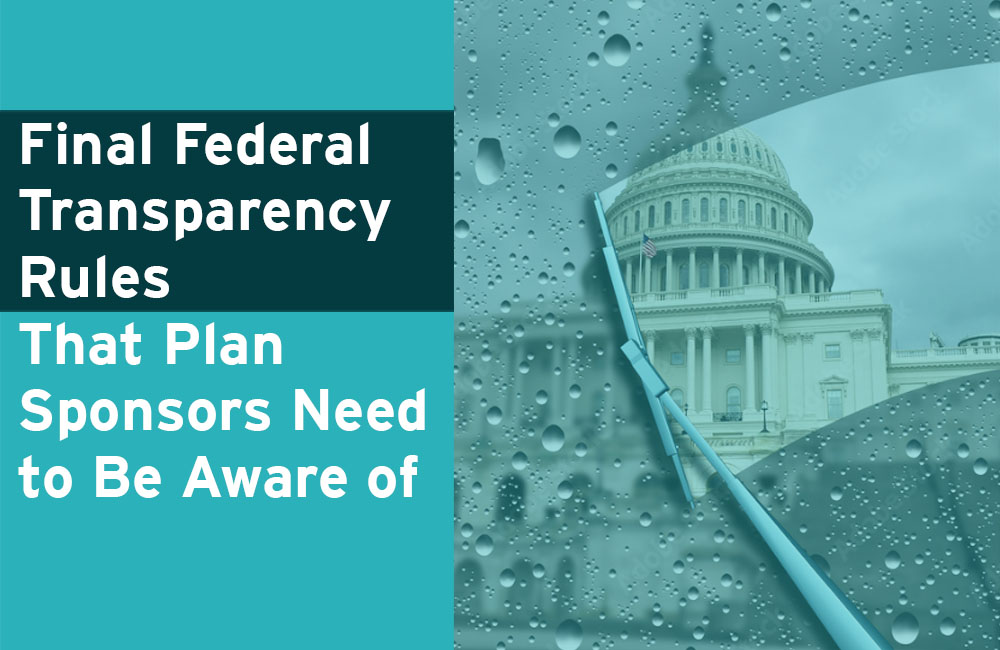
Final Federal Transparency Rules That Plan Sponsors, As Fiduciaries, Need to Be Aware of
Much has happened since the June 2019 White House executive order that prompted the Hospital Price Transparency Act.
In November 2020, the Departments of Labor (DoL), Health and Human Services (HHS), and the Treasury released the Transparency in Coverage. External Link. Opens in new window. final rules applicable to employer health plans. Shortly after, Congress passed the omnibus Consolidated Appropriations Act of 2021 (CAA). Several provisions impact both health plans and providers, including additional transparency requirements and the No Surprises Act.. External Link. Opens in new window.
Employer plans must make good faith efforts to comply with phased requirements, even when delegating tasks to benefits partners. As fiduciaries, plan sponsors must intend to:
- Ensure regulatory awareness
- Minimize liability
- Improve their employees’ health plan
That said, let’s review the current transparency rules and preview upcoming requirements on the horizon.
Hospital Price Transparency Act for Plan Sponsors
The rule requires hospitals to publish payor-specific rates and offer tools for patients to estimate costs before services. This gives patients the ability to shop for that procedure. Unfortunately, the number of hospitals in full compliance is low, even after the penalties were raised. External Link. Opens in new window. for those out of compliance.
Consolidated Appropriations Act (CAA) for Plan Sponsors
The CAA is bipartisan legislation intended to provide clarity around cost accountability and to provide plan sponsors with access to their data in order to act in a fiduciary manner. It requires plan sponsors to ensure that health benefits are cost-effective and high-quality, similar to their pension and 401(k) plans’ fiduciary responsibility. There are five key transparency elements of the CAA that are important for plan sponsors to follow, and a sixth on the provider side to be aware of:
New Disclosure requirements
- Impacts information listed on ID cards and in provider directories. Future rules will require plans to provide enrollees with an “advanced explanation of benefits” before receiving services.
Prohibits gag clauses
- Service provider contracts must not prohibit you from using your data to benchmark providers or empower enrollees to shop for higher-value services.
Requires the disclosure of all compensation from all service providers
- Plan Sponsors need to disclose direct compensation, finder’s fees, contracted fees, commissions, and all other indirect compensation in excess of a thousand dollars from brokers, TPAs, PBMs, stop-loss carriers, etc.
Required parity in substance abuse and mental health benefits
- Mandates that employers offering mental health and substance use disorder coverage provide analyses to the DoL upon request comparing these benefits to covered medical/surgical benefits to demonstrate compliance with parity requirements.
Prescription Drug Disclosure
- Plans must submit information to the tri-agencies, including information about the prescription drugs that are driving claims and costs and total healthcare expenditures for the applicable year, broken down in various ways.
Good Faith Estimates
- As of January 1, 2022, healthcare providers are required to provide good faith cost estimates to patients that are uninsured or that don’t plan to submit their claim to a health plan. This requirement will also apply to insured patients.The health plan will receive the estimate to prepare the advanced EOB.
Transparency in Coverage (TiC) Rules for Plan Sponsors
The health plan TiC rules created a set of comprehensive requirements for plan sponsors to disclose estimated cost-sharing information to promote good consumerism by individuals. They would require a plan sponsor to provide meaningful cost-sharing information, upon request, for a covered item or service in connection with an in-network provider, or an out-of-network allowed amount for a covered item provided by an out-of-network provider.
These requirements would apply to all self-insured and fully-insured employer plans. They will be enforced beginning July 1, 2022, in three phases:
- Phase One requires health plans to disclose hospital pricing information by posting on a public website two machine-readable files:
- One containing rates for all covered items and services between the plan or issuer and all in-network providers
- One containing all allowed amounts for, and billed charges from, out-of-network providers.
- Phase Two is slated to go into effect in 2023. This phase consists of an internet-based comparison tool allowing patients to receive estimates of their cost-sharing responsibilities for 500 shoppable items or services from specific providers.
- Phase Three, going into effect in 2024, will expand the internet-based tool to all items and services. All information must be provided, upon request, in paper form and requests by phone must be accommodated. The Department of Labor has published a set of FAQs. External Link. Opens in new window. on the TiC and CAA coverage transparency requirements.
The Alliance is Your Compliance Advocate
We understand new rules and requirements are not always clear-cut. The Alliance is your strongest advocate when it comes to price transparency. We help your employees find high-value care, and properly implemented regulations can support these efforts.
The Alliance also acknowledges its role in supporting our employer-members’ compliance with these federal transparency regulations. We continually educate and update TPAs managing our employer-member health plans on the tools and resources we’ve developed. We’re actively looking to coordinate our efforts where possible to ensure our employer-members are compliant with these regulations.
With the July 1, 2022, deadline approaching, does your organization have a plan to meet transparency file requirements? Have you connected with your TPA to ensure they are ready to support your compliance? Will you be using an entity other than your TPA to support this provision? Have you considered hiring an ERISA attorney? They can help you with compliance, similar to what you may do for your retirement plan process.
Let us know. Our Transparency Team can provide your TPA or designated partner with the information they need to support your compliance.
You can find more information about the Federal Transparency Regulations here: CMS 9915-F. External Link. Opens in new window.
To learn more about self-insured health plans, check out our Benefit Plan Design page.







